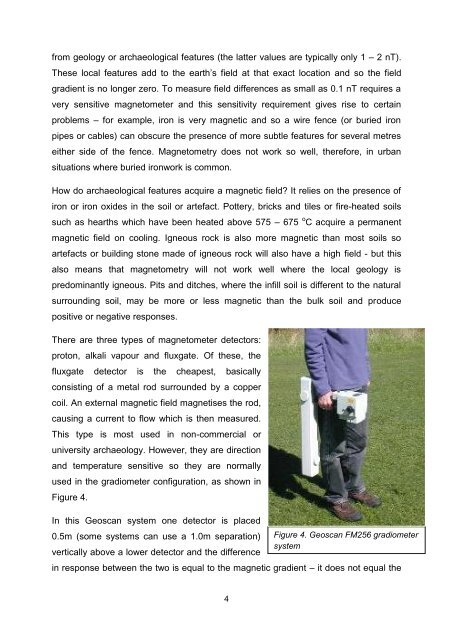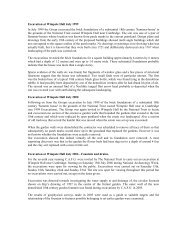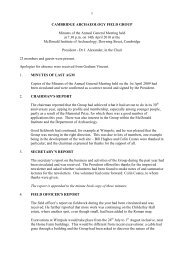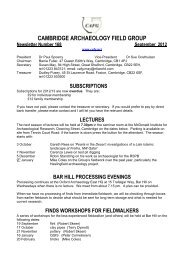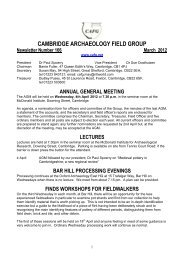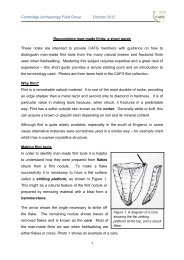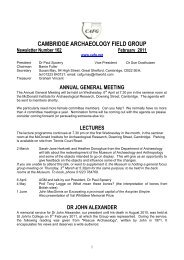What is Geophysics? - Cambridge Archaeology Field Group
What is Geophysics? - Cambridge Archaeology Field Group
What is Geophysics? - Cambridge Archaeology Field Group
You also want an ePaper? Increase the reach of your titles
YUMPU automatically turns print PDFs into web optimized ePapers that Google loves.
from geology or archaeological features (the latter values are typically only 1 – 2 nT).These local features add to the earth’s field at that exact location and so the fieldgradient <strong>is</strong> no longer zero. To measure field differences as small as 0.1 nT requires avery sensitive magnetometer and th<strong>is</strong> sensitivity requirement gives r<strong>is</strong>e to certainproblems – for example, iron <strong>is</strong> very magnetic and so a wire fence (or buried ironpipes or cables) can obscure the presence of more subtle features for several metreseither side of the fence. Magnetometry does not work so well, therefore, in urbansituations where buried ironwork <strong>is</strong> common.How do archaeological features acquire a magnetic field? It relies on the presence ofiron or iron oxides in the soil or artefact. Pottery, bricks and tiles or fire-heated soilssuch as hearths which have been heated above 575 – 675 o C acquire a permanentmagnetic field on cooling. Igneous rock <strong>is</strong> also more magnetic than most soils soartefacts or building stone made of igneous rock will also have a high field - but th<strong>is</strong>also means that magnetometry will not work well where the local geology <strong>is</strong>predominantly igneous. Pits and ditches, where the infill soil <strong>is</strong> different to the naturalsurrounding soil, may be more or less magnetic than the bulk soil and producepositive or negative responses.There are three types of magnetometer detectors:proton, alkali vapour and fluxgate. Of these, thefluxgate detector <strong>is</strong> the cheapest, basicallycons<strong>is</strong>ting of a metal rod surrounded by a coppercoil. An external magnetic field magnet<strong>is</strong>es the rod,causing a current to flow which <strong>is</strong> then measured.Th<strong>is</strong> type <strong>is</strong> most used in non-commercial oruniversity archaeology. However, they are directionand temperature sensitive so they are normallyused in the gradiometer configuration, as shown inFigure 4.In th<strong>is</strong> Geoscan system one detector <strong>is</strong> placed0.5m (some systems can use a 1.0m separation)vertically above a lower detector and the differenceFigure 4. Geoscan FM256 gradiometersystemin response between the two <strong>is</strong> equal to the magnetic gradient – it does not equal the4


